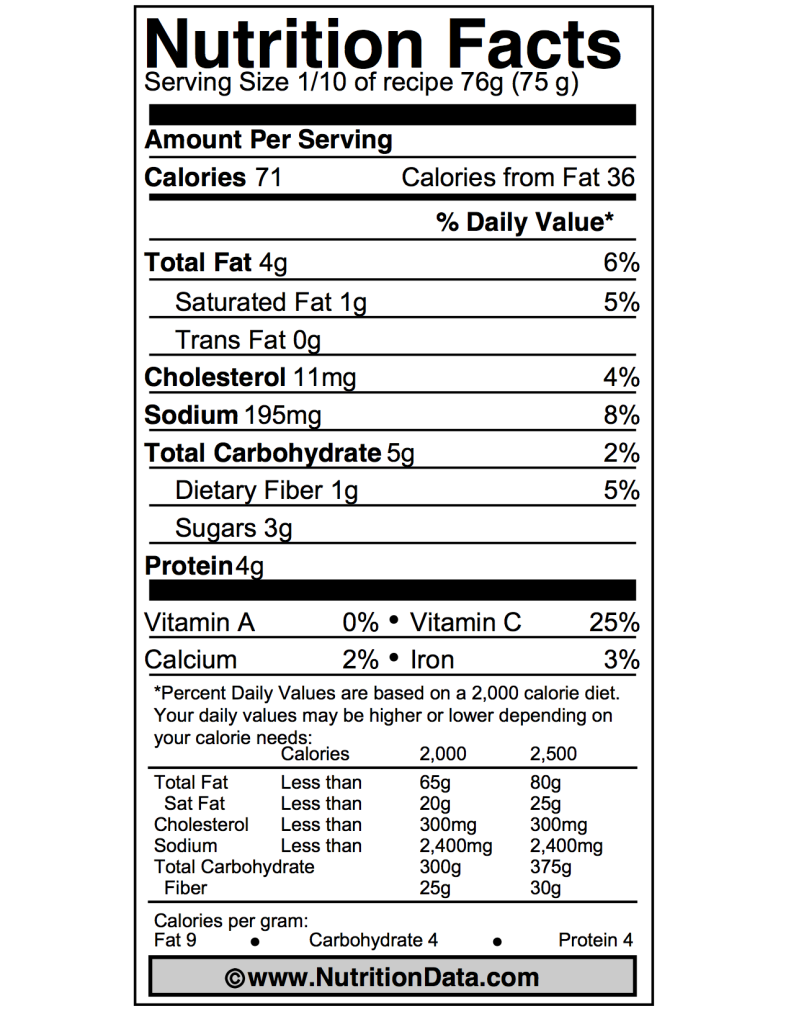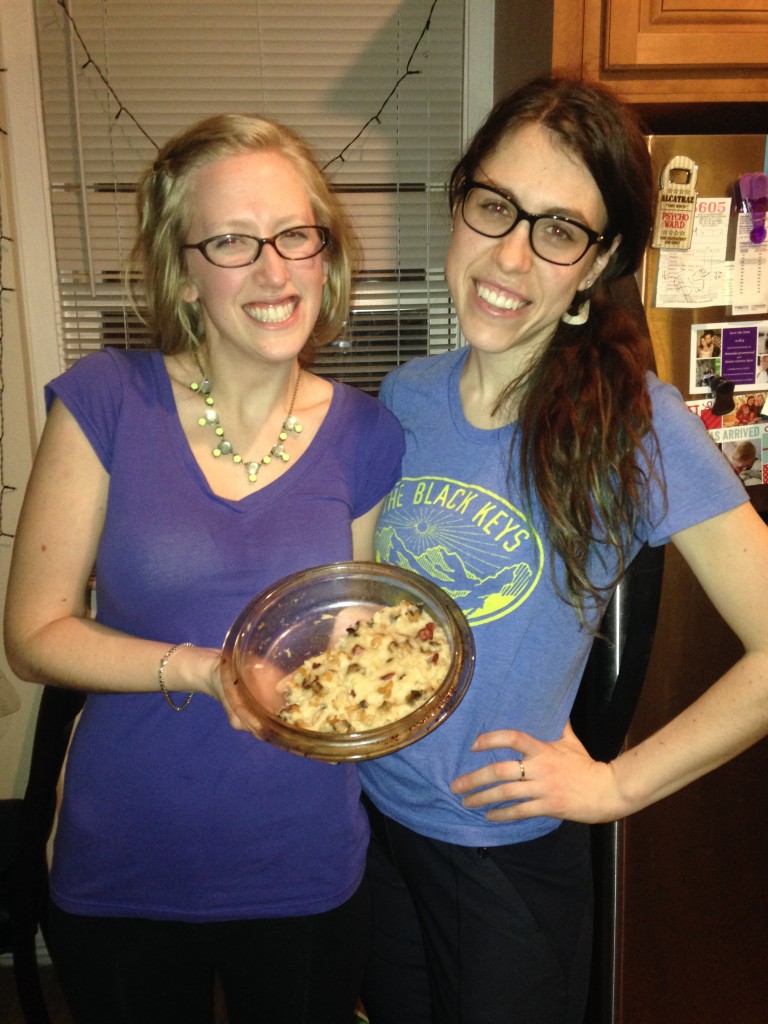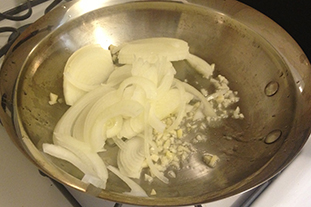Cooking, for whatever reason, can be intimidating. Maybe it is the fire and knives? Maybe it is the possibility of poisoning yourself or your loved ones? Or maybe it’s just because being a chef seems like a glamorous career for geniuses. The thing is, though, it’s not as hard as it seems. Like any other skill, it just takes some learned skills, practice, and the willingness to make a few mistakes.
I consider myself a chef, though I am not “in the industry,” which was my response when a waiter at an upscale brunch place asked me where I worked after seeing my culinary-inspired tattoo. And, you know what? That’s okay! People are quick with an apologetic, “Oh, I’m a terrible cook!” when it’s time for the staff meeting potluck. Instead, I challenge you to appreciate the effort you put in to feeding yourself! Let me start you off with three intimidating foods that are easier than they sound, and all of which can be cooked in a saucepan. Which is a pot, by the way. A small pot, that in restaurants might be used for sauces, but in many 20somethings’ kitchens is mostly used for 1-2 servings of Annie’s mac and cheese.
1. Boiled Egg
Why Make It?
Have you ever sliced a hard-boiled egg with fresh ground pepper for a mid-morning snack? Piped some tasty egg yolk and mayo mixture into delicious deviled eggs? Slurped a warm soft-boiled beauty with your miso-filled ramen bowl? They are well worth the effort. Though this first dish might be like skating through easy-town for some readers, I do give some tips and tricks (one I just learned last week!) to make things easier, so check it out.
The Technique
You will need a saucepan, a medium sized bowl, and eggs for this.
Place the eggs in your saucepan and fill it with enough water to cover the eggs about an inch. Don’t go running for a ruler; I usually just approximate with the first joint of my index finger.
Cover the saucepan and bring it to a boil. It is important to boil the water with the eggs already inside because 1) the cook time accounts for the cooking they’ll do as the water boils and 2) if you drop them into already boiling water, they will crack and not be beautiful and perfect.
When the water is boiling, turn off the heat and move the saucepan to a cool burner, leaving the lid on to keep the heat in. Set the timer for your desired egg done-ness using the following useful chart from No Recipes (this site has an extensive egg boiling article—definitely worth a read!):
2 minutes – The white isn’t fully set, and the yolk is totally raw
4 minutes – The white is fully set, but the yolk is thick and runny
6 minutes – The white is fully set, and the yolk is mostly set but still a little runny in the middle
8 minutes – The white is fully set, and the yolk is set but tender
10 minutes – The white is fully set, and the yolk is fully set
As you wait, prepare your ice bath: fill the medium-sized bowl with cold water and ice cubes. I usually leave it in the sink so I can do a quick dump. I hold the lid partially on to keep the eggs in the saucepan while I dump out the water, then I move the lid out of the way to dump the eggs right into their ice bath. This is because I am lazy about dish-washing; a colander would suit just fine.
After a minute or two in the ice bath, they will be cool enough to touch. I pick them up, bang them on all sides with the back of a spoon to make cracks all over the shell, and put them back in the water. If I want one right away, I might pull it out and peel it then and there, but ideally they should sit for a bit so the water can get under the shell and loosen it to make peeling easier. And you’re done!
Tips and Tricks
By far the biggest issue for egg boiling is the peeling. If you’ve ever found yourself attempting to peel and egg and instead removing chunks of tasty white (that’s food in there!), you know what I mean. This is especially annoying if you want to serve these to people and want them to look smooth and flawless.
My mom always told me to just use older eggs (as in, near their expiration date). This does work for science reasons that I don’t understand just yet. But if you can’t wait that long (and who can?), there is another trick. Before cooking your egg, take something with a small but rounded edge (I used the butt of my rolling pin handle). Take your raw egg in one hand and hold the rolling pin steady with the other. Whisper a short prayer to your deity of choice, and then tap the wide butt end of the raw egg gently against the tip of the rolling pin handle. You want to hear a tiny crack that breaks a bit of the shell but not the membrane of the egg. I was sure this would end in a mess and tears, but it totally worked and made peeling at the end a lot easier.
2. Jam
Why Make It?
When most people picture jam-making, they picture a kitchen full of Laura Ingalls Wilders, out in the middle of nowhere, all wearing kerchiefs over their hair and wiping sweat from their brows with their forearms as they use both hands to stir an enormous, thick vat of goo that will last the winter. But that is not at all an accurate depiction of the time and effort involved! Jam is actually fairly quick and easy to make, especially if you are only making a couple jars and do not plan on proofing (sealing the lids so they can sit out at room temperature for ages). And with the delightful ability to mix flavors to your own personal preference and look like a gourmet BAMF, there is no reason not to.
The Technique
First, supplies: To make jam, you’ll need some sterile* mason or Ball jars (with the flat lids and twist rings), fruit, sugar, lemon juice, and pectin (available at most larger grocery stores, in the baking aisle, by the Jello). Choose the No Sugar Needed Pectin—it works the best even if you do use sugar (which you will, I imagine).
You’ll also want a pot and probably a funnel, to ease more jam into the jar.
* To sterilize them, boil the jars, lids, and rings in a big pot before you put the finished jam inside. This kills all bacteria. Washing the in dishwasher will do the trick too.
Now, recipes: Different jam recipes have different ratios, so I’ll start with a specific favorite of mine: strawberry lavender. For lots of recipes, proofing times, and just generally great advice, check out PickYourOwn.org, a website with terrible design but a lot of knowledge. It walked me through my first canning experience.
Strawberry Lavender Jam
Buy/pick some strawberries! You’ll need about twice as many cups of whole strawberries as you want cups of complete jam. So if you want 6 cups of jam, you’ll need 12 cups of whole berries.
Wash them, hull them (cut the leaves and white part out with a small knife), and cut them into pieces. The smaller you cut them, the faster they will break down in the jam.
Prepare your sugar by blending 4 cups of sugar in a food processor with 4 tablespoons of edible lavender buds (available at specialty spice stores). I do this one cup at a time ‘cause my food processor is small. You could also probably get away with chopping up the lavender very finely as well.
In your saucepan, mix ¼ cup of your lavender sugar with 1 ½ packages of pectin (SureJell or another brand, doesn’t matter). Feel free to play with this amount as you cook. As you make more jam, you’ll find the perfect ratio for you.
Cook this mixture over medium high heat for about 5-10 minutes, until the mixture is at a full boil (remains boiling even when you stir).
Add the rest of the sugar and allow it to come to a boil again. Don’t raise the heat too high, though, as that creates more foam. Keep at a full boil for 1 minute. Speaking of foam, feel free to scoop that off and toss it in the sink. It’s just bits of jam with too much air.
Remove from heat and test for thickness. Do this by keeping a teaspoon in a glass of cold water. When you take the saucepan off the heat, dip the spoon to get a bit of jam and let it cool to room temperature. If it looks thick enough, hooray! If not, add a little more pectin and cook a bit longer.
When the jam is cooked to perfection, use a funnel to move it into the jars. If you plan to use and eat or give away the jars to people who will use or eat them right away, you don’t need to proof them. If you want to save them, then…
Proofing!
If you want to make more than a jar or two, you’ll likely want to proof (or seal) your jars to get rid of all bacteria and allow them to sit safely on the shelf without going bad.
To proof them, fill with jam, screw on the lid and ring, and place them into a big pot of boiling water. There should be a few inches of water over the top of the lid. Depending on the jam, they will need to proof for different amounts of time—check online. When the time’s up, remove them from the pot and let them sit out and cool overnight at least. Within 30 minutes, you should hear a “pop” to tell you the can has properly sealed—if not, keep it in the fridge and eat it soon. Aside from a big pot, you’ll probably want something to lift them out of the boiling water (I used big tongs once, but then I went to Target and got an actual jar lifter and it was fantastic).
Tricks and Tips
Jam-making includes a lot of equipment and, for that reason, it’s super helpful to have everything lined up and ready to go. Make sure you have your sugar and pectin measured out and lots of oven mitts and hot-thing-holders on hand. Your jars, lids, and twist rings should be clean and ready, too.
You also want to be aware of temperature. Pouring hot jam into a cold jar could cause the glass to break, so you will want to sterilize your jars while prepping your jam. I usually do this by allowing the jars to boil away for about 10 minutes in a big pot on the stove while I’m cutting up the fruit. If I’m just making a few jars worth and not planning on proofing, I wash the jars in hot water to warm up the glass while the jam thickens.
Depending on the fruit you are using, your jam will be different consistencies at different temperatures. I found, for example, that blackberries thicken up nicely in the saucepan and stay at a similar consistency in the fridge. Strawberries and prickly pears (the fruit of cacti), however, don’t seem to thicken much in the saucepan, causing you to bite your nails and continue adding pectin, which all comes together strongly when the jar is cooled, making your jam a bit stiffer than desirable. So don’t worry if it doesn’t thicken like you think it should—it could just be the type of fruit. Do more research online.
Finally, note that pectin will lose its magical thickening abilities if you up the recipe too much, so work in small batches. The recipe I provide above is about as much as you want to do at one time in one pot. But there is no reason not to have two pots going at once!
3. Pastry Cream
Why Make It?
Pastry cream, though super delicious, probably seems like something that Julia Child or Martha Stewart would make, not you. What do you do with it anyway? Well, if you’re like me, you use it to impress your friends and neighbors! Obviously pastry cream is integral for tasty pastry creation, if you’re working on fruit tarts or Danishes or donuts. But it is also an integral ingredient in a very simple, very fun, very beautiful dish know as a trifle. This dish is meant to be made ahead and then refrigerated, making it easy to bring to potlucks and get-togethers, impressive and convenient to serve at a dinner party, and fun to assemble and eat with groups for a bridal or baby shower or a birthday party.
Pastry Cream Recipe
You’ll need:
- 2 cups of milk/cream (I usually combine 1 cup of whipping cream and 1 cup of milk; half and half works too)
- ½ cup sugar
- Pinch of salt
- 5 large egg yolks (save the whites – you can make an omelet later!)
- 3 tablespoons cornstarch (flour is fine too)
- 4 tablespoons of butter (1/2 a stick)
- 1½ teaspoons vanilla extract
Before you start cooking, prepare an ice bath to quickly cool your pastry cream. Get two large bowls, one slightly (but not much) bigger than the other. Fill the bigger one with cold water and ice and float the small inside the larger. Finally top it off with a mesh strainer balanced on the top. Put this ice bath to the side for the end of your recipe.
Heat the cream/milk in a saucepan until simmering. Watch out! Milk comes to an overflowing boil within seconds of starting to simmer. Keep an eye on it.
Whisk the sugar, pinch of salt, and 5 egg yolks together in a large bowl. You want to whisk for a good long time, until the mixture turns more of a paler yellow than the brighter yellow it started out as. Add in the cornstarch/flour.
If the milk has started to simmer by now, please, feel free to remove if from the burner and turn off the stove.
Now it’s time to combine the two mixtures. Be careful—doing this too fast will cook the eggs. You are going to do a process called tempering, in which you add a little bit of the hot milk/cream to the egg, sugar, flour mix to slowly warm it up. Drizzle about a tablespoon of hot liquid into your bowl and immediately whisk it to spread the heat evenly and avoid cooking one small spot. Repeat this a few times—you should be whisking for as much of this time as possible. I usually add about 1/3 of my cream this way.
When the mixture seems to be fairly warm, use a spatula to scrape the mixture back into the saucepan with the rest of the hot milk/cream. Return it to medium heat. Using a whisk or silicon spatula or wooden spoon, stir constantly while the mixture cooks. You are heating up the cornstarch/flour so it thickens the mixture, plus kills any bacteria in your eggs.
Continue whisking, even though you are super bored, for about 5 minutes. It could take longer or shorter, depending on the temperature of your ingredients. If you let it sit, you will scorch the bottom of the pastry cream. You’ll know it’s time when you see these cool-looking, thick bubbles of pastry cream in the saucepan. When you see that, continue for 30 seconds to a minute longer, then remove saucepan from the burner.
Off the stove, add in your butter and vanilla, and stir to combine.
Now, turn to your ice bath. Use a spatula to scrape the custard into mesh strainer, to get rid of any lumpy bits. It won’t fall through on its own, so you’ll need to hold the strainer and use the spatula to push it through.
Allow it to sit 10-15 minutes and cool a bit, then take plastic wrap and cover the bowl. Make sure the plastic wrap comes down inside the bowl, pressing against the top layer of pastry cream and coming up the inside sides of the bowl. Sounds weird, but this keeps the pastry cream from developing a skin. Allow it to set for at least 3 hours in the refrigerator.
Tips and Tricks
Believe it or not, this is one of the easiest fancy things to make. As long as you don’t add your hot milk to your cold eggs too fast or cook the final product without stirring, your pastry cream will be delicious.
To play with other flavors, consider soaking herbs in the milk/cream while it heats. Mint is delicious, but basil and even rosemary create a really unique and tasty final product. Make sure you remove the leaves before combine the milk with the eggs and sugar.
You can also add chocolate chips at the end with the butter and vanilla for a tasty chocolate-y flavor!
And that’s it! Hopefully you will be breaking out your saucepan for more exciting things this weekend!
























